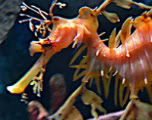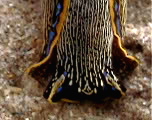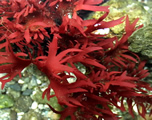

Temperate corals and sessile invertebrates require minimal lighting in comparison to their tropical cousins. Basic fluorescent light fixtures will work well in aquariums with these specimens. Most are plankton feeders or get nutrition from other carnivorous food sources as they lack the zooxanthellae of corals and anemones located in tropical regions. This allows them to survive in the sometimes dismal weather of temperate regions.
The only true coral commonly available to the temperate hobbyist is the orange cup coral since most coldwater corals are found in deep water. Anemones and sponges often dominate the temperate reef of the shallow temperate oceans. This is the primary reason that the a fore mentioned species are most commonly found in home aquaria.
Anemones
Aggregating Anemone (Anthopleura elegantissima) • Giant Green Anemone (Anthopleura xanthogrammica) • Strawberry Anemone (Corynactis californica) • Brooding Anemone (Epiactis lizbethae) • Proliferating Anemone (Epiactis prolifera) • Plumose Anemone (Metridium senile) • Stubby Rose Anemone (Urticina coriacea) • White-Spotted Rose Anemone (Urticina lofotensis)
Corals
Orange Cup Coral (Balanophyllia elegans)
Hydrocoral
Stick Hydrocoral (Eudendrium ramosum) • Encrusting Hydrocoral (Stylantheca porphyra)
Sea Cucumbers
Red Sea Cucumber (Cucumaria miniata)
Sponges
Red Beard Sponge (Microciona prolifera) • Velvety Red Sponge (Ophlitaspongia pennata) • Smooth Red Sponge (Plocamia karykina)













